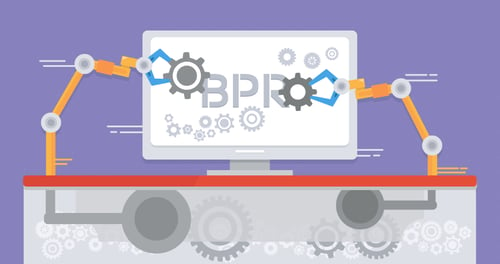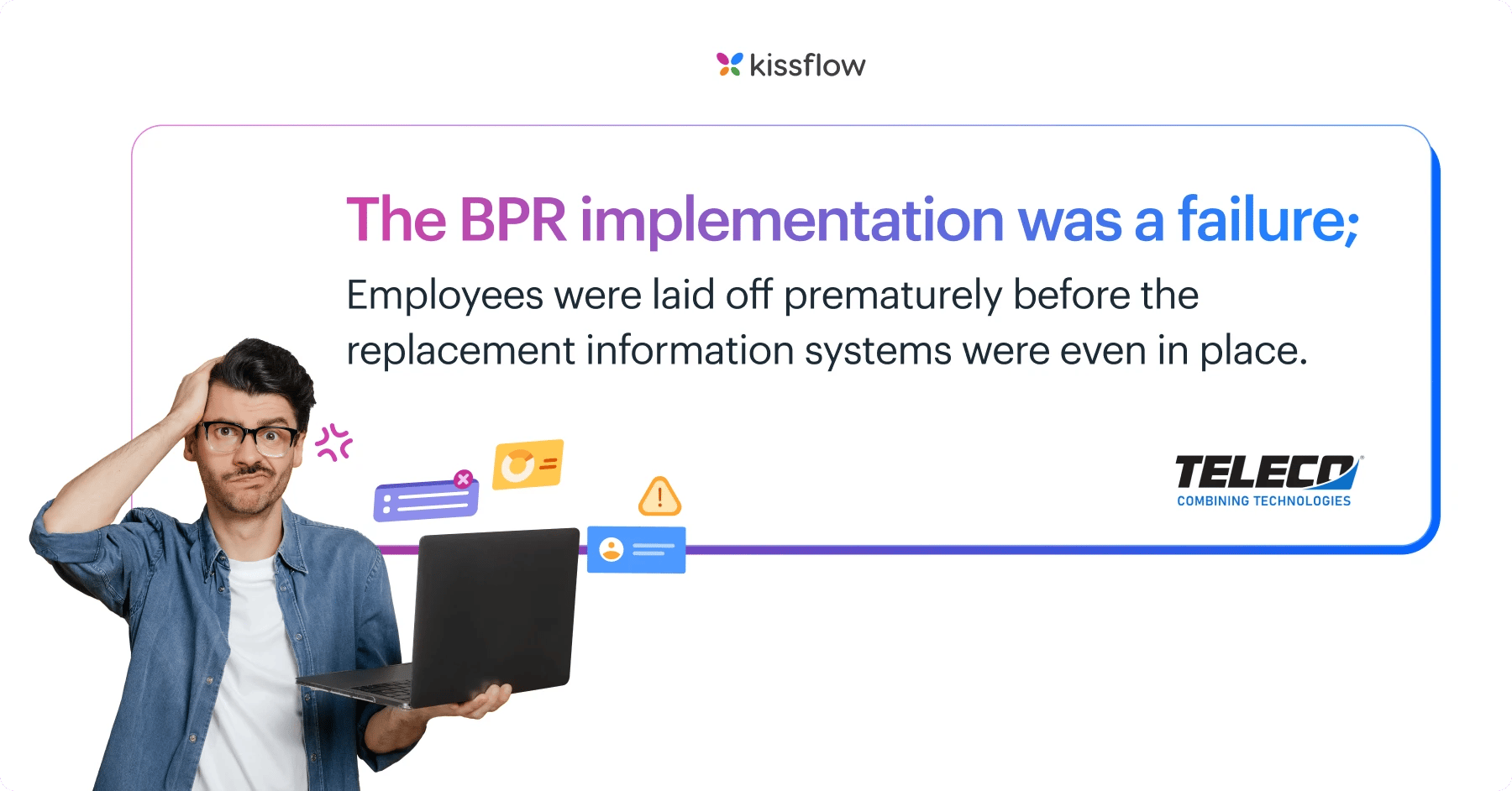
- >
- BPM Software >
- Business Process Reengineering (BPR) – When It’s Time to Obliterate
Business Process Reengineering (BPR) – When It’s Time to Obliterate
Business Process Reengineering Definition
If business process improvement is fine-tuning your car, then business process reengineering is doing a total engine overhaul.
For CIOs constantly seeking ways to innovate and align IT strategy with business goals, BPR offers a powerful tool to reimagine existing processes. Unlike other Business Process Management (BPM) initiatives, BPR doesn't settle for incremental improvements. Instead, it demands a radical rethink, an extreme redesign of processes to achieve remarkable results. Business process reengineering (BPR) helps organizations reimagine their existing processes and take extreme redesign measures to achieve remarkable results.
BPR is different from other BPM initiatives because it revamps a process entirely rather than making repeated improvements to it. Successfully implementing BPR isn't just about saving costs or speeding up processes; it's about fundamentally bettering product and service quality. In this era of rapid technological change, CIOs face complex challenges, and BPR emerges as a strategic solution to navigate these complexities and drive transformative success.
BPR Blows It Up
In 1990 an MIT professor, Michael Hammer, wrote an article titled, “Don’t Automate, Obliterate” which fuelled BPR’s popularity as a revolutionary concept. Hammer writes:
It is time to stop paving the cow paths. Instead of embedding outdated processes in silicon and software, we should obliterate them and start over. We should “reengineer” our businesses: use the power of modern information technology to radically redesign our business processes in order to achieve dramatic improvements in their performance.
Businesses love BPR for its no-nonsense, blitzkrieg approach to completely blot out waste from processes.
Of Tacos and Tauruses
BPR gained more steam when Fortune 500 companies started adopting business process reengineering (BPR) as their new weapon of choice to eliminate process redundancies and shoot up workflow efficiency.
In one of the early examples of BPR’s success, Ford Motor Company examined their Accounts Payable department. In the early 1990s, they employed 500 people in accounts payable to manage a very complicated system. They also had inefficiencies throughout the system and many errors. Through some basic improvements with IT, they thought they could reduce their workforce by 20%. However, when they realized that Mazda employed only 5 people in their accounts payable, they realized something more drastic was needed.
Using BPR, Ford:
- Introduced the concept of “Invoiceless Processing”
- Reduced their workforce by 75%
- Digitized its accounting process
- Improved vendor relationships
Taco Bell’s K-Minus initiative is another example of a successful BPR initiative. The retail food service company decided to move the food preparation job from its restaurants to a centralized commissaries in 1989. The decision helped them:
- Achieve greater quality control
- Lessen employee injuries in restaurant kitchens
- Encourage employees to deliver better customer service
When to Use Business Process Reengineering (BPR)
The benefits of BPR are countless – increased revenue, improved customer service, reduced cost, higher employee retention, faster processing time. Nearly any business benefit can be gained from business process reengineering.
However, the key is when to use BPR. Here are some key times when you might want to think about obliterating your processes and starting fresh:
- When technology has significantly disrupted your industry
- When a competitor does drastically more with less (think Mazda)
- When you need to be the disruption in your industry
- When a little improvement won’t make much difference
The Pitfalls Of Business Process Reengineering
Business process reengineering (BPR) is not a silver bullet to revive tangled up, sloppy processes. It fails when companies mistake BPR for a way to automate, downsize, or outsource.
A business process reengineering (BPR) initiative flops when organizations:
- Apply it to more than one process
- Don’t have long-term, clear goals
- End up with only minor changes to the process
- Don’t dare to put their processes on the anvil
- Apply it continually, reengineering processes yearly or more often
- Focus more on automation than redesign
A Case Study of BPR Failure

In the mid-1990s, US telecommunications company TELECO adopted BPR to fight the toughening market competition. But due to factors like poor communication from leadership, prematurely letting go of employees, uncoordinated execution, and lack of awareness about BPR tools, the initiative failed to deliver results. The teams at TELECO did not follow the business process reengineering steps which ended up in a waste of money and time.
Read the full story here:
Difference Between BPM and BPR
Business process management is the methodology of how to manage and optimize existing processes. Organizations often use business process improvement as a way to manage their on going processes. However, business process management (BPR) means essentially trashing the old process and starting fresh with a blank slate.
A quick run-down of how BPI and BPR differ:
Business Process Improvement(BPI) |
Business Process Reengineering (BPR) |
|---|---|
| Refines and/or automates existing processes | Reengineers processes from the ground up |
| Has low risk factors | Has high risk factors |
| Costs less | Costs more |
| Results are incremental | Yields drastic results |
| Takes less time to implement | Requires longer implementation time |
| Generally uses a BPMS to make improvements | Is platform-agnostic when it comes to designing the new process |
| Can be applied on many processes simultaneously | Focuses on redesigning one process at a time |
The strategic significance of BPR for enterprises
Business Process Reengineering (BPR) is a strategic approach that helps businesses fundamentally rethink their existing processes to improve performance metrics such as cost, quality, service, and speed. Here's how BPR aligns with broader business objectives, transformation initiatives, and the need for continuous innovation:
Alignment with Business Objectives:
BPR supports strategic business objectives by increasing efficiency and effectiveness. By redesigning processes from the ground up, companies can eliminate redundancies, streamline operations, improve customer service, and reduce costs. This can help businesses achieve their goals faster and more efficiently.
Supporting Transformation Initiatives:
BPR is often a key component of larger digital transformation initiatives. As businesses adopt new technologies, they often need to reengineer their processes to take full advantage of these tools. BPR can help identify bottlenecks, inefficiencies, or outdated practices holding back transformation efforts.
Fostering Continuous Innovation:
BPR encourages a culture of continuous innovation. Companies can stay agile and adaptable by constantly questioning and reevaluating how work is done. This mindset can help businesses keep up with industry changes, take advantage of new opportunities, and stay ahead of competitors.
Integrating Emerging Technologies:
In today's digital age, BPR can be crucial in integrating emerging technologies such as AI, machine learning, and automation into business processes. By redesigning processes with these technologies in mind, businesses can drive innovation and stay on the cutting edge of their industries.

The Ultimate Buyers guide to BPM Software
Thank you for reaching us!
Thank you for reaching us!
Business Process Reengineering Steps
Broadly speaking, business process reengineering steps can be put into a five-stage progressive plan:
1. Select Process for Reengineering
Specify an individual process that’s causing problems and evaluate what’s wrong with it.
2. Define Process Objectives
Specify the goals you want to realize, and communicate clearly with all stakeholders.
3. Identify Reengineering Enablers
Is your culture ready for a change? Do you have IT/technological competency to make things happen?
4. Formulate A New Redesign
Rewrite process prototypes by ignoring the existing process rules and finalize on the best fit.
5. Execute The New Process
Train team members on the new process and new tools to execute it. Once the new model is proved successful, convert to regular business process improvement.
Check out why this Best BPM Tool is at the top of the competition!
Example Scenario: Revolutionizing Supply Chain in Manufacturing
In business process reengineering (BPR), consider a manufacturing giant needing an updated supply chain. During the analysis phase, they uncover issues like excessive inventory and delays in sourcing raw materials. Moving into the redesign phase, they envision a lean, demand-driven supply network. They use BPR principles to eliminate bottlenecks, introducing real-time monitoring and automated replenishment. The new model is visualized using BPR methodologies, providing clarity to teams. Implementation involves adopting advanced supply chain software and training employees. As lead times decrease and costs plummet, the optimization phase refines the process iteratively based on performance metrics. This example underscores how BPR can reshape operations, even in complex industries like manufacturing.
BPR Statistics
- An Accenture study found that two-thirds of companies that adopted reengineering saw improvements in one or more of their processes by more than 500 percent.
- The American health insurance giant CIGNA applied business process reengineering (BPR) to many of its projects like customer service and expense operations and was able to save as much as $100 million.
- A survey by a consulting firm, Arthur D. Little, on North American businesses discovered that 85% of executives surveyed were dissatisfied with the results of BPR projects.
- The Three biggest obstacles to BPR implementation: Lack of commitment in leadership, expecting too much too soon, and resistance to change.
Core BPR Principles
If you want your BPR initiative to succeed, remember this advice from Michael Hammer’s original article:
Think Cross-Functionally
Your process likely touches many departments. If you only try to change things within one department, your efforts may not make a difference.
Keep asking “Why” and “What if”
BPR works because it stretches the boundaries and doesn’t assume the current solution is the only one.
Organize around outcomes, not tasks
Don’t think up a better way to do the individual tasks in a process. Focus on the outcome and the simplest way to get there.
Let those closest to the work make the final decisions
There is tremendous insight in those people who have performed a function a thousand times over. Ask them how improvements can be made and give them decision-making power.
Capture information once, at the source
Much of the redundancies in processes involve the manual transfer and resubmission of data. Collect the data once, and use IT systems to parse it out to every task after that
BPR Reimagined with Kissflow
Kissflow is a low-code development platform that empowers your teams to build custom applications. By integrating automated workflows, it streamlines and optimizes business processes, thereby significantly enhancing productivity and efficiency across your organization.It facilitates better process management, streamlining workflows, and eliminating redundant steps to enhance productivity.
Modern business automation software enables teams to move beyond manual, repetitive tasks and focus on work that drives real value. It acts as a central hub where workflows, data, and collaboration come together for greater efficiency and accuracy.
The Business Process Improvement (BPI) methodology enables businesses to examine their processes and identify redesign opportunities, aligning with BPR's goals. Kissflow's visual editor allows easy automation of reengineered processes. It also emphasizes restructuring outdated processes for long-term operational efficiency—key in BPR—and enables businesses to simulate process efficiency before implementing changes. While Kissflow supports BPR efforts, successful reengineering also requires a clear strategy, strong leadership, and readiness to embrace organizational change.
.
Related Articles










